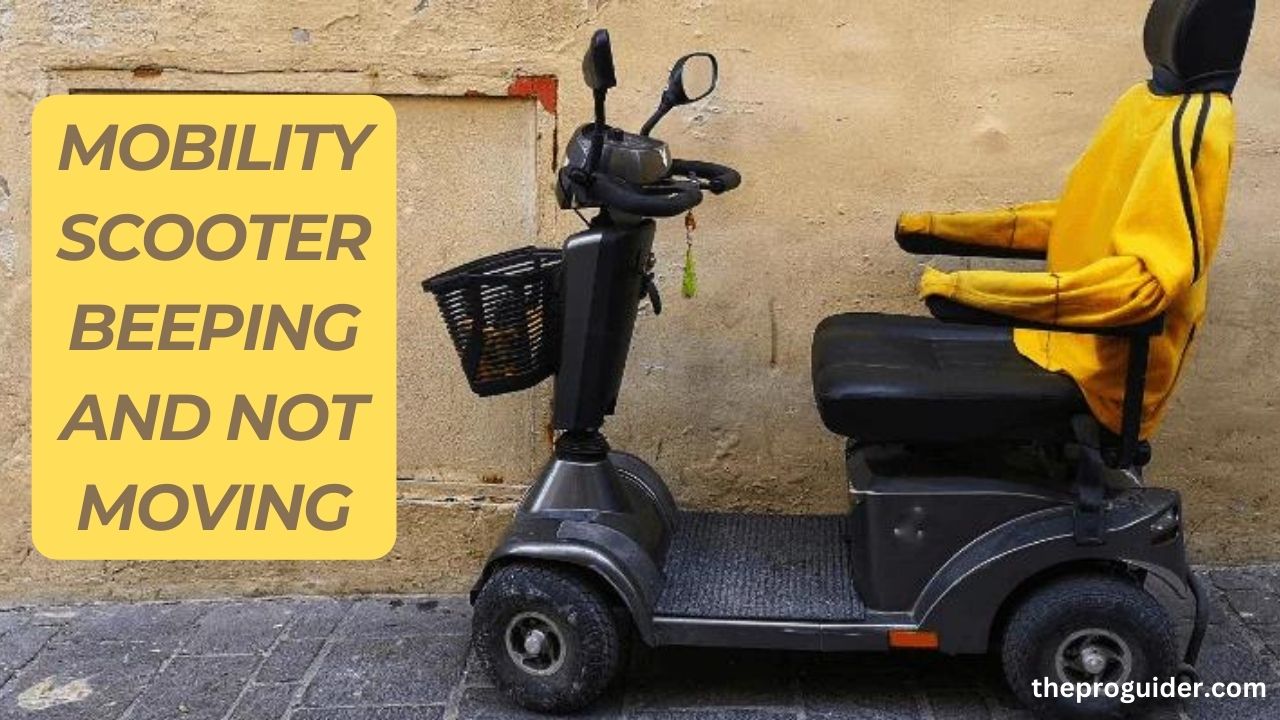In this blog post, we’re going to talk about a common problem that some people face with their mobility scooters when they start beeping and won’t move. Mobility scooters are really important for people who need help getting around, so it can be frustrating when they don’t work properly.
We’ll explore why this happens and provide some simple explanations to help you understand what might be going wrong. By the end of this post, you should have a good idea of what to check and how to fix the issue, making sure your mobility scooter keeps you moving safely and smoothly.
Table of Contents
ToggleCommon Causes of Beeping and Non Movement
When your mobility scooter starts beeping and refuses to move, several common issues might be causing the problem. Understanding these causes can help you diagnose and fix the issue efficiently. Here are some of the most frequent reasons why your mobility scooter might be beeping and not moving:
Low Battery:
One of the most common reasons for beeping and non movement is a low battery. Mobility scooters rely on batteries to power their motors. If the battery charge is too low, the scooter may beep to indicate this and may not have enough power to move.
Faulty Connections:
Loose or damaged electrical connections can disrupt the flow of power from the battery to the motor. If any wires are loose or connectors are damaged, the scooter may beep as a warning that there is a problem with the electrical system.
Motor or Controller Issues:
Problems with the motor or controller can also cause the scooter to beep and not move. If the motor is malfunctioning or if there are issues with the controller that regulates its operation, the scooter may not respond properly.
Obstruction or Jamming:
Sometimes, the scooter may beep because there is an obstruction or the wheels are jammed. This could be due to debris caught in the wheels or a mechanical issue that prevents the scooter from moving freely.
Overheating:
If the scooter’s motor or controller overheats, it may trigger a beeping sound as a safety precaution. Overheating can occur due to prolonged use or operating the scooter in hot weather conditions.
By understanding these common causes, you can begin troubleshooting your mobility scooter to identify the specific issue and take appropriate action to resolve it. In the following sections, we’ll delve deeper into each of these potential problems and provide practical solutions to help you get your mobility scooter back up and running smoothly.
Battery Troubleshooting
Battery troubleshooting is often a crucial step in addressing issues with a mobility scooter that is beeping and not moving. Here are some steps you can take to troubleshoot the battery:
Assess Battery Voltage:
Check the battery’s voltage with a multimeter. A fully charged battery typically reads around 12.8 volts. If the voltage is significantly lower, it may indicate that the battery is depleted and needs recharging or replacement.
Charging the Battery Correctly:
Ensure that the battery is properly connected to the charger and that the charger is plugged into a working power outlet. Follow the manufacturer’s instructions for charging the battery and allow sufficient time for it to fully charge.
Inspect Battery Connections:
Check the battery terminals and cables for any signs of corrosion, rust, or damage. Clean the terminals with a wire brush or terminal cleaner to ensure good contact. Tighten any loose connections to the battery terminals securely.
Replace Faulty Battery:
If the battery is old or damaged and does not hold a charge effectively, it may need to be replaced. Consult your scooter’s user manual or contact the manufacturer for information on compatible replacement batteries.
Extend Battery Life:
Practice good battery maintenance habits to prolong the life of your scooter’s battery. Avoid overcharging or completely draining the battery, and store it in a cool, dry place when not in use. Periodically check the battery voltage and recharge as needed to maintain optimal performance.
By following these battery troubleshooting steps, you can determine if the battery is the source of the problem with your mobility scooter. If the battery appears to be in good condition and fully charged, but the scooter still beeps and does not move, you may need to explore other potential issues such as faulty connections or motor problems.
Checking Connections
Checking connections is an essential step in troubleshooting a mobility scooter that is beeping and not moving. Here’s how to check the connections:
Inspect Wiring Harnesses:
Start by examining the wiring harnesses throughout your mobility scooter. Look for any loose, frayed, or damaged wires. Pay close attention to areas where wires connect to components such as the battery, motor, and controller.
Tighten Loose Connections:
If you find any loose connections, use a screwdriver or appropriate tool to tighten them securely. Ensure that all electrical connections are snug and secure to maintain proper conductivity.
Check Battery Connections:
Verify that the battery terminals are securely connected to the scooter’s wiring harness. Clean the battery terminals with a wire brush or terminal cleaner to remove any corrosion or debris that may inhibit proper electrical contact.
Inspect Controller Connections:
Examine the connections between the controller and other components of the scooter, such as the throttle and motor. Ensure that all connectors are firmly seated and that there are no signs of damage or corrosion.
Look for Damaged Connectors:
Inspect all connectors for signs of damage, including cracks, breaks, or melted insulation. Damaged connectors can disrupt the flow of electricity and cause the scooter to malfunction.
Test Connectivity:
Use a multimeter set to the continuity or resistance mode to test the connectivity of the wiring and connectors. Check for continuity between corresponding pins or terminals to verify that electrical signals can flow freely.

Repair or Replace Defective Connections:
If you identify any damaged or faulty connections, repair or replace them as needed. Cut and strip wires to expose fresh, clean metal before reconnecting them. Replace damaged connectors with new ones to ensure reliable electrical connections.
By carefully inspecting and testing the connections within your mobility scooter, you can identify and resolve any issues that may be causing it to beep and fail to move. Properly secured and functioning connections are essential for maintaining the electrical integrity of your scooter and ensuring safe and reliable operation.
Motor and Controller Examination
Examining the motor and controller of your mobility scooter is crucial when troubleshooting issues like beeping and non movement. Here’s how to proceed:
Diagnosing Motor Problems:
- Listen for Unusual Sounds: Turn on the scooter and listen for any unusual noises coming from the motor. Grinding, clicking, or whirring sounds could indicate motor issues.
- Testing Motor Functionality: Check if the motor is receiving power by engaging the throttle. If there is no response or if the scooter only moves intermittently, there may be a problem with the motor.
Assessing Controller Issues:
- Understanding Error Codes: Some scooters are equipped with diagnostic systems that display error codes when there’s a problem. Refer to your scooter’s manual to interpret any error codes displayed.
- Resetting the Controller: Try resetting the controller by turning off the scooter, waiting for a few minutes, and then turning it back on. This may reset any error codes and resolve minor issues.
- Testing Controller Outputs: Use a multimeter to test the outputs of the controller. Ensure that the controller is sending the correct signals to the motor and other components of the scooter.
Visual Inspection:
- Examine Wiring: Inspect the wiring harnesses connected to the motor and controller for any signs of damage, such as frayed wires or loose connections. Make sure there are no rust or loose connections.
- Check for Overheating: Touch the motor and controller after operating the scooter for some time. If they feel excessively hot to the touch, it could indicate overheating issues.
Professional Assistance:
- If you’re unable to diagnose or repair motor or controller issues on your own, consider seeking assistance from a professional technician who specializes in mobility scooter repair.
- A qualified technician can perform advanced diagnostic tests and repair or replace faulty components as needed.
Replacement Parts:
If motor or controller issues are identified, contact the manufacturer or a reputable supplier to obtain replacement parts. Ensure that you use compatible parts recommended by the manufacturer to maintain the scooter’s safety and performance standards.
Also Read: swagtron hoverboard red light flashing and beeping
Conclusion
In wrapping up, it’s essential to understand that when your mobility scooter beeps and doesn’t move, it could be due to various common issues like low battery, faulty connections, or motor problems. Regularly checking and maintaining your scooter can prevent these issues. If you encounter persistent problems or are unsure about the solutions, seek professional assistance.
Remember, your safety and mobility are paramount, and addressing these concerns promptly will ensure your scooter continues to serve you well. Stay proactive in caring for your scooter, and enjoy the freedom and independence it provides in your daily life.
